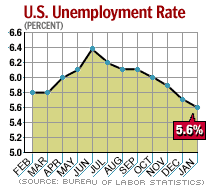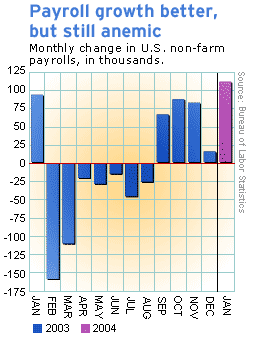NEW YORK (CNN/Money) -
U.S. payroll employment continued to slowly improve in January, the government said Friday, in a report that disappointed Wall Street's hopes for a more vigorous recovery.
But the unemployment rate fell again, to its lowest level in two years, leaving a long-standing economic mystery unresolved -- is the labor market on the road to a full recovery, typical of past expansions, or will structural changes in the economy keep job growth anemic?

Payrolls outside the farm sector grew by 112,000 jobs, the Labor Department said, compared with an upwardly revised gain of 16,000 in December.
It was the fifth straight month of payroll gains and the biggest gain since December 2000 -- but only because higher gains in prior months were revised sharply lower.
The unemployment rate fell to 5.6 percent, the lowest level since January 2002, from 5.7 percent in December.
Economists, on average, had expected 165,000 new jobs -- one forecast was for payroll growth as high as 300,000 jobs -- and unemployment at 5.7 percent, according to Briefing.com.
"This report is a slow boat to China, reflecting continuing business caution about hiring people," said Sung Won Sohn, chief economist at Wells Fargo. "Facing unprecedented competition from both domestic and foreign sources, businesses are still focused on productivity gains with as few employees as possible."
On Wall Street, stock prices ignored the disappointment and rose, but Treasury prices also rose, pushing bond market interest rates lower. Bond prices and yields move in opposite directions.
Fed on hold, Bush looks at bright side
The report seemed unlikely to inspire the Federal Reserve to move quickly to raise its key short-term interest rate. Typically, central bankers want to see much stronger job growth for several months before they're convinced the economy is strong enough to withstand a rate hike.
| 
| |

| 
| 
|

|
 Labor Secretary Elaine Chao gives her perspective on the latest unemployment and job creation numbers. Labor Secretary Elaine Chao gives her perspective on the latest unemployment and job creation numbers.
|
 Play video
Play video
(Real or Windows Media)
|
| 
|

|
|
"The report is certainly better than in December, but it just doesn't reflect the level of job creation we'd expect to see at this stage of the economic recovery, or the job creation the Fed would need to see to even consider taking that first step towards tightening," said former Fed economist Lara Rhame, now senior economist with Brown Brothers Harriman.
The report also did little to settle the vast discrepancy between the household survey, which generates the unemployment rate, and the broader survey of businesses, which produces the payroll figure. According to the household survey -- which includes the self-employed -- employment grew by nearly 500,000 people in January.
But Rhame said she estimates household employment is still about 3 million jobs below where it should be based on historical patterns, while payroll employment is about 4 million jobs lower than it should be.
The nation has lost about 2.35 jobs million since March 2001, the month the last recession began, the longest stretch of labor market weakness since World War II. Nearly 800,000 of those jobs have disappeared since the recession ended in November 2001.
| Related stories
|

|
|
|
|
A weak job market could prove tough for President Bush as the November election approaches. When pushing for tax cuts last year, Bush promised his proposals would create 300,000 jobs a month, which hasn't happened yet and may not happen at all in 2004.
"We are a long way from getting back the jobs lost since President Bush took office," said Rep. Pete Stark, D-Calif., ranking Democrat on the Joint Economic Committee.
But Labor Secretary Elaine Chao, speaking to CNNfn, touted the falling unemployment rate, the growth of the labor force, and the growth in jobs in both the household and employer surveys.
"Today's news is good news," Chao said.
Revisions bring payrolls lower
Some economists had hoped that the department's annual revisions to the last 12 months of payroll growth would have raised the number of workers on payrolls, revealing thousands of jobs at new start-up businesses.

But the revisions actually drove the payroll total lower by about 81,000 -- though they did make January's payroll growth the strongest since 124,000 in December 2000.
"We need more jobs. It is accurate to say that job growth has returned, but it is not at an acceptable level," said Joel Naroff, president and chief economist at Naroff Economic Advisors in Holland, Pa. "We need over 200,000 a month to feel good about the sustainability of the expansion. That may be coming, but it is not here yet."
In its report, the department said service industries such as education and health care added 105,000 jobs in January. Retailers hired 76,000 workers but temporary help payrolls fell by 21,000, the first drop in nine months. Typically, temp hiring is a sign employers are gearing up to make permanent hires.
Manufacturing shed 11,000 jobs, the 42nd straight month of falling factory payrolls. The factory sector has lost 3.3 million jobs since early 1998, and many of those jobs are never coming back, having been moved overseas or made obsolete by technological improvements.
In fact, those sort of structural changes could be affecting more than just the factory sector, making this labor market different from those in the past, some economists believe.
"Today's labor market does not fit the mold of the old models," said John Silvia, chief economist at Wachovia. "The economy has recovered, and many of the old jobs are gone."
Weakness in the details
The department said the percentage of people who've stopped looking for work, who are unemployed but still looking or working part time until they find something better held at 9.9 percent, near the highest level since 1996.
The percentage of long-term unemployed held near the highest level since 1992.
Average hourly wages rose 2 cents to $15.49 but earnings have grown just 2 percent in the past 12 months, near the lowest level since 1987. Wage growth is crucial for consumer spending, which fuels two-thirds of the economy.
The average work week edged up to 33.7 hours, indicating a slight pickup in business activity. But that was the same as October 2001, in the midst of the last recession, and is only a tenth of a percentage point above the shortest on work week on record.
"This is not a good report, all things considered," said Richard Yamarone, chief economist at Argus Research.

|

